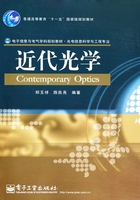
4.7 磁光效应[54],[55]
当光在磁化介质中或者处于外磁场中的介质内传播时,光的偏振、相位或散射等特性发生变化,这种现象称为磁光效应。磁光效应包括磁光法拉第效应、磁光克尔效应、磁线振双折射(科顿-穆顿-沃伊特效应)、磁圆振二向色性、磁线振二向色性、塞曼效应和磁激发光散射等。磁光效应在信息技术方面有广泛应用,例如磁光开关、调制器、隔离器、环形器、旋光器、磁光传感器和磁光存储器等器件都利用了磁光效应。
4.7.1 几类主要的磁光效应
1.磁光法拉第效应
线偏振光沿着外磁场方向或磁化方向通过介质,偏振面发生旋转,这种效应称为磁光法拉第效应。实际上,出射光不仅偏振面发生旋转,一般也由入射时的线偏振光变成出射时的椭圆偏振光,如图4.7-1所示。该效应是法拉第在1845年首先发现的,当时他将一块玻璃置于一对磁极之间,发现沿外磁场方向的入射光经玻璃透射后,其偏振面发生了旋转。后来,韦尔代(Verdet)经过深入全面的研究,发现偏振面旋转的角度θ与光在物质中传播的距离d及磁场强度H成正比,即

式中,V称为韦尔代常数。磁光实验还表明,所有透明物质都可以产生磁致旋光效应,不同物质的磁致旋光能力不同。另外,偏振面旋转的方向取决于磁场方向,即当磁场反向时,偏振面的旋转方向也反向。因此,如果偏振光往返通过在磁场中的介质或者磁化介质,则与初始状态相比,光矢量的振动方向旋转的总角度为单程通过介质时旋转角度的两倍。这一点与自然旋光的特性不同。前文指出,偏振光往返通过旋光物质时,光矢量的振动方向将恢复到原来的方向。而在法拉第效应中,偏振光往返通过在磁场中的介质或磁化介质时,旋转角朝一个方向增大,反映了磁致旋光现象的非互易性。
2.科顿-穆顿-沃伊特效应
当线偏振光垂直于磁场强度方向通过介质时,光波按电矢量垂直于磁场方向和平行于磁场方向分成两束,这两束光的折射率不同,由此产生的磁致双折射现象,称为科顿-穆顿-沃伊特效应。一般出射光是椭圆偏振光,椭圆主轴相对于入射的线偏振光旋转一个角度,如图4.7-2所示。

图4.7-1 磁光法拉第效应示意图

图4.7-2 科顿-穆顿-沃伊特效应示意图
1898年,德国物理学家沃伊特(W. Voigt)发现光在垂直于磁场方向通过蒸汽或液体时,在这些本为各向同性的物质中产生双折射现象,这种现象称为沃伊特效应。1907年,法国物理学家科顿(A. Cotton)和穆顿(H. Mouton)将强磁场施加在透明液体(如硝基苯液体)上,当光垂直于磁场方向通过液体时,表现出极强的双折射效应,比此前发现的沃伊特效应大三个数量级,此效应称为科顿-穆顿效应。现在常将这两种磁致双折射效应统称为科顿-穆顿-沃伊特效应。
3.磁圆振二向色性与磁线振二向色性
当光沿着平行于外磁场方向或磁化方向通过介质时,介质对入射的左、右旋圆偏振光的吸收不同,这种现象称为磁圆振二向色性,如图4.7-3(a)所示。
当光沿着垂直于外磁场方向或磁化方向通过介质时,入射的偏振光可以分解成平行于外磁场方向或磁化方向及垂直于外磁场方向或磁化方向两个偏振光分量,介质对这两个偏振光的吸收不同,这种现象称为磁线振二向色性,如图4.7-3(b)所示。

图4.7-3 磁光二向色性效应示意图
4.磁光克尔效应
线偏振光入射到处于外磁场中或磁化介质表面,经反射后其偏振态发生变化,这种现象称为磁光克尔效应。根据光的入射面、界面与磁场或磁化强度的不同取向,磁光克尔效应通常分成三种类型,分别为:(a)极向克尔效应,即外磁场或磁化强度方向与界面垂直时的磁光克尔效应,如图4.7-4(a)所示;(b)横向克尔效应,即外磁场或磁化强度方向与界面平行并垂直于光的入射面时的磁光克尔效应,如图4.7-4(b)所示;(c)纵向克尔效应,即外磁场或磁化强度方向平行于界面及光的入射面时的磁光克尔效应,如图4.7-4(c)所示。
磁光克尔效应是克尔于1876年首先发现的,当时他发现线偏振光在电磁铁的磨光磁极面上反射后变成椭圆偏振光。

图4.7-4 磁光克尔效应示意图
4.7.2 圆偏振光与磁光效应
磁光效应主要是物质在外磁场作用下或磁化后对左、右旋圆偏振光产生不同的响应造成的。图4.7-5所示为磁光效应与圆偏振光运动状态的关系。线偏振光可以看作是振幅与初相位都相同的左、右旋圆偏振光的合成,如图4.7-5(a)所示。如果左、右旋圆偏振光的振幅相同,但初相位不同,则合成的线偏振光相对于纵轴旋转一定的角度,如图4.7-5(b)所示。当左、右旋圆偏振光的初相位相同,而振幅不同时,合成的偏振光为椭圆偏振光,其长轴沿纵轴方向,如图4.7-5(c)所示。当左、右旋圆偏振光的初相位与振幅均不同时,合成的偏振光为椭圆偏振光,其长轴相对纵轴旋转一定的角度,如图4.7-5(d)所示。

图4.7-5 磁光效应与圆偏振光运动状态的关系示意图
磁致旋光的方向与磁场方向有关,当迎着磁场方向观察时,光的偏振方向按逆时针旋转,规定为正旋,其韦尔代常数取正值。前文提及,虽然自然旋光与磁致旋光都引起光的偏振面旋转,但两者有很大的区别。在旋光物质中,旋转方向与传播方向有固定的关系,当光通过旋光物质时,观察者顺着光传播方向看,若偏振面按顺时针旋转,则当光沿原路经返回时,顺着传播方向看偏振面仍然按顺时针旋转,但与原来旋转方向相反,这样再次通过旋光物质后,净旋转角为零。在磁光效应中,旋转方向仅与磁场方向有关,当光的传播方向与磁场方向一致时,迎着光传播的方向观察,如果偏振面按顺时针旋转,则当光经反射后沿原路返回时,迎着反射光传播的方向观察,偏振面按逆时针旋转,因此旋转方向与原来旋转方向一致,这样再次通过磁光物质后,旋转角便为单程时的2倍。
4.7.3 磁光效应的经典理论
1.磁化介质的介电张量
对于各向同性介质,未磁化时相对介电张量εr为

为简便起见,下面的讨论中略去εr及εrxx下标中的r,即令ε≜εr及εxx≜εrxx。当沿z方向施加磁场,介质的对称性遭到破坏。但绕z轴仍有旋转对称性,如施加90°旋转操作,有

这里C4为绕轴旋转90°的变换矩阵,即

将式(4.7-4)代入式(4.7-3),得到

因此,ε具有下列形式

磁光现象源于光与物质的相互作用,原则上对其精确描述需用量子力学方法。但借助于经典的谐振子理论,也可得出一些重要的结论。依照经典理论,将光学跃迁用一个圆频率为ω0和阻尼因子为Γ的谐振子的共振模型来解释。假设质量为m,电荷为-e的电子在圆频率为ω的光场和外磁场H的共同作用下,其运动方程为

这里r是电子的位矢。设方程(4.7-7)的解为

代入上式可得

假设H∥z轴,即有

则



其中 为电子受洛伦兹力的作用作圆周运动的圆频率,称为回旋频率。式(4.7-11)表明电子沿z轴方向运动受到阻尼作用,只有在xy面上的运动可以持续进行。因为H∥z轴,使沿x轴与y轴的运动通过洛伦兹力相互耦合。由式(4.7-11)可得x、y满足的方程为
为电子受洛伦兹力的作用作圆周运动的圆频率,称为回旋频率。式(4.7-11)表明电子沿z轴方向运动受到阻尼作用,只有在xy面上的运动可以持续进行。因为H∥z轴,使沿x轴与y轴的运动通过洛伦兹力相互耦合。由式(4.7-11)可得x、y满足的方程为



从中解得x(t)、y(t)、z(t)为



由此可得极化强度P的分量为



将式(4.7-13)代入式(4.7-14)得



由此可得在磁场作用下,介质中的相对介电张量为

I为单位张量(其对角元为1,非对角元为0)。一般在磁场中,ε的各元素是磁场H的函数,ε具有下列形式

与式(4.7-2)中未磁化时的介电张量ε相比,在有外磁场的情况下,介电张量出现不为0的非对角元。根据昂色格(Onsager)关系(参见附录C),有

可见,ε的对角元是磁场的偶函数,非对角元是磁场的奇函数。在一级近似下,非对角元正比于外磁场;当外磁场反向时,非对角元将反号。
2.光在磁性介质中的传播
光在介质中传播时满足麦克斯韦方程


其解为平面波,即


k为波矢,假设光波沿z轴正向传播,则

 为复折射率,且
为复折射率,且 =n+iκ,n为折射率,κ为消光系数。将式(4.7-21)代入式(4.7-20)可得
=n+iκ,n为折射率,κ为消光系数。将式(4.7-21)代入式(4.7-20)可得


将式(4.7-22)代入式(4.7-19)可得


式中  为z轴的单位矢量。从式(4.7-23)中消去H可得
为z轴的单位矢量。从式(4.7-23)中消去H可得

式中,ε用式(4.7-6)代入得

或者

上式有E≠0的解存在,系数行列式必须为0,即

于是得 的本征值为
的本征值为

将式(4.7-28)代入式(4.7-25)得

即

设 分别为x、y方向的单位矢量,则本征函数E±为
分别为x、y方向的单位矢量,则本征函数E±为

其中E+对应左旋圆偏振光,E-对应右旋圆偏振光。说明在磁光介质中本征模为左、右旋圆偏振光。
3.磁光法拉第效应
当介质磁化后,介电张量中非对角元不为零。当光在介质中传播时,物质对左旋圆偏振光和右旋圆偏振光的响应不同而产生磁光法拉第效应。下面讨论该效应中的旋转角和椭圆率与介电张量元的关系。
如前所述 的本征值为
的本征值为  ,其中
,其中
 ,一般
,一般 与
与 相差很小,令Δn=n+-n-,Δκ=κ+-κ-,n=(n++n-)/2,κ=(κ++κ-)/2。于是有
相差很小,令Δn=n+-n-,Δκ=κ+-κ-,n=(n++n-)/2,κ=(κ++κ-)/2。于是有




由上式解得


式(4.7-33)给出了Δn、Δκ与介电张量元的关系。下面建立Δn、Δκ与观察量θ F、ηF之间的关系。

图4.7-6 磁光法拉第效应坐标系的选取
如图4.7-6所示,设振动面在xz平面的线偏光E in沿z轴传播,x轴的单位矢量为 ,y轴的单位矢量为
,y轴的单位矢量为 ,则
,则

将式(4.7-34)写成振幅相等的左旋圆偏振光和右旋圆偏振光的叠加形式,则有

其中, 分别为左、右旋圆偏振光的单位矢量,即
分别为左、右旋圆偏振光的单位矢量,即


左旋圆偏振光、右旋圆偏振光在物质中的折射率分别用 表示。设z=0,则传播到z=d处的相位分别为exp(iω
表示。设z=0,则传播到z=d处的相位分别为exp(iω +d/c)和exp(iω
+d/c)和exp(iω -d/c),其中
-d/c),其中 。出射光的电场矢量Eout为
。出射光的电场矢量Eout为

其中,Δ ,进一步,若
,进一步,若 ,则出射光为
,则出射光为


若绕z轴将坐标系旋转θ= ,变成坐标系x'y'z',其单位矢量为
,变成坐标系x'y'z',其单位矢量为 ,则有
,则有

于是有

如果Δκ=0,即没有磁圆振二向色性,则Eout仅有 分量,是沿x'轴振动的线偏振光,表明入射光的偏振方向旋转θ角,此即法拉第旋转角θF,即
分量,是沿x'轴振动的线偏振光,表明入射光的偏振方向旋转θ角,此即法拉第旋转角θF,即

有些文献将旋转角的符号定义为,从面向光源的观察者来看右旋为正,则有

若Δκ≠0,则式(4.7-40)描写的光为以x'轴为长轴,y'轴为短轴的椭圆偏振光。
法拉第椭圆率定义为椭圆偏振光的短轴与长轴振幅的比,即

由式(4.7-41)、式(4.7-43)及式(4.7-32)得


根据上式,将θF、ηF以 表示为
表示为


这样将磁光法拉第效应与介电张量的非对角元联系起来。通常磁光法拉第效应用透明的物质测得,因此κ=0,于是有


法拉第椭圆率与磁圆振二向色性可以用公式联系起来。注意到,光的吸收系数α=2ωκ/c,圆振二向色性Δα为左旋圆偏振光的吸收系数α+与右旋圆偏振光的吸收系数α-之差,因此有

利用式(4.7-43)得

需要指出,此处的α表示吸收系数,注意不要与4.6.1节的旋光率混淆。
4.磁光克尔效应
设入射光沿z轴传播,沿x轴方向振动,则有

若介质对左旋圆偏振光与右旋圆偏振光的反射率分别是r+exp(iθ+),r-exp(iθ-),则反射光可由下式给出

将
 ,Δθ=θ+-θ-,θ=(θ++θ-)/2,Δr=r+-r-,r=(r++r-)/2代入式(4.7-50)得
,Δθ=θ+-θ-,θ=(θ++θ-)/2,Δr=r+-r-,r=(r++r-)/2代入式(4.7-50)得

将 坐标旋转
坐标旋转 得
得 ,即
,即


则

易见式(4.7-53)表示椭圆长轴自x轴方向按逆时针旋转-Δθ/2,并且椭圆率为ηk=Δr/(2r)的椭圆偏振光。因此


下面讨论磁光克尔效应观测量θk,ηk与介电张量元之间的关系。根据

式中,n0为环境介质的折射率,若环境介质为空气,则n0=1;n、κ分别为磁光介质的折射率和消光系数。式(4.7-55)中,r、θ分别表示为


将上式微分得


结合式(4.7-54)和式(4.7-57),经计算可得


从上式求得Δn、Δκ为


根据式(4.7-32)可得


将Δn,Δκ的表达式(4.7-59)代入上式得


反之,也可用介电张量的非对角元来表示θk,ηk,经过运算可得


由式(4.7-62)可以导出下式

θk,ηk满足K ra m ers-K ro nig关系,即


5.科顿-穆顿-沃伊特效应
在法拉第效应中,光的传播方向与磁场的方向一致;而在科顿-穆顿-沃伊特效应中,光的传播方向与磁场方向垂直。假设未加外磁场时介质为各向同性,加外磁场后引起单轴各向异性,使得平行于外磁场HEX振动的线偏振光和与垂直于HEX振动的线偏振光具有不同的折射率;振动方向与HEX平行的光为寻常光(或o光),与HEX垂直的光为非寻常光(或e光)。

图4.7-7 科顿-穆顿-沃伊特效应讨论中坐标系的选取
设外磁场HEX沿z方向,光波沿x轴的正向传播,如图4.7-7所示。假设光波具有下列形式


将式(4.7-65)代入麦克斯韦方程组,经过运算可得

上面方程存在非零解,因此系数行列式为零,由此得久期方程为

于是得到 的两个本征值,它们分别为
的两个本征值,它们分别为


将 代入式(4.7-66)得Ex与E y的关系如下
代入式(4.7-66)得Ex与E y的关系如下

于是得到本征函数为

将 代入式(4.7-66)得
代入式(4.7-66)得

若εxy=0,则E1沿y方向振动;若εxy≠0,则E1在xy面内振动。结果说明,虽然光的波法线方向沿x轴,但能量传播方向沿与x轴夹角为arctan(εxy/εxx)的方向,此光为非寻常光;而E2沿z轴方向振动,此光为寻常光。假设εxy=0,计算相位延迟δ,得到

由此可见,δ与磁场的偶次幂相关。
若入射光是沿与y轴成θ角方向振动的线偏振光,令

当光波出射时,y方向与z方向分量间有δ的相位差,令 ,两列波的合成为
,两列波的合成为

将 坐标旋转θ角变换为
坐标旋转θ角变换为 坐标,即
坐标,即


上式逆变换为


将此式代入式(4.7-74)得

若θ=π/4,则

出射光是以与y轴、z轴分别夹π/4角的 为主轴的椭圆偏振光,椭圆率为
为主轴的椭圆偏振光,椭圆率为

用检偏器将与入射光的偏振方向垂直的分量取出,其强度为

在式(4.7-77)中,令δ=π(通过适当选取材料的长度即可实现),则

可见,出射光为与 轴成-2θ角的线偏振光,而
轴成-2θ角的线偏振光,而 轴与入射光振动方向一致。
轴与入射光振动方向一致。